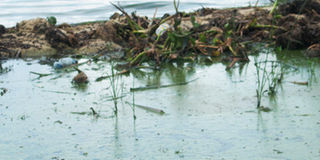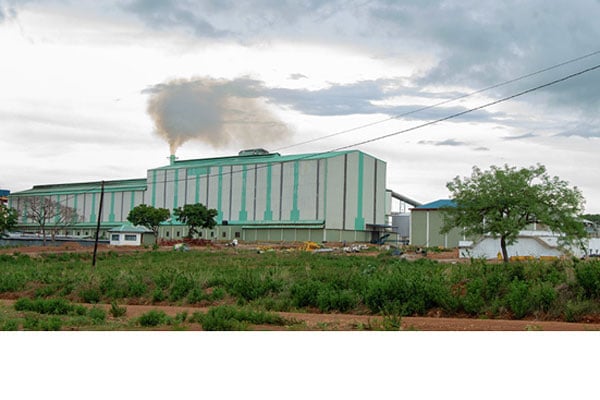Prime
The sad story of Lake Victoria

The lake water has turned green due to pollution. Left: Is the Minister in charge of water bodies, Maria Mutagamba. Right: Monitor employes take a boat ride on the lake. PHOTO BY EDWIN NUWAGABA
Waste management remains a problem in Uganda. This has caused pollution of the environment including the soil and water. Edwin Nuwagaba looks at how pollution has impacted on Lake Victoria and how environmentalists are dealing with the problem.
Back in my secondary school days, we were taught the properties of water. We were told by the chemistry teacher that water is actually colorless. And in geography, we were told Lake Victoria was one of the world’s fresh water bodies and that the areas surrounding it received regular rainfall with high crop yields. This appears to have drastically changed.
First, when I visited Murchison Bay in Luzira recently, I found something different about water. The water here had turned dark green.
Reason? The experts said Lake Victoria had been polluted. And the pollution had put the entire lake at risk of drying up.
The surrounding areas now experience long spells of heat. And according to experts, Lake Victoria, is now greatly at risk of environmental degradation because unplanned development around it has destroyed the lake’s catchment area.
The wetlands and swamps around the lake have been encroached on and some wiped out. “More and more people have been moving towards the lake because of its fertile soils and its reliable rainfall,” said Mr Simon Thuo, a water expert at Nile Basin Initiative.
Expert opinion
According to Mr Thuo, the biggest urban centres in the country like Jinja, Masaka Municipalities and Kampala City are located around the lake, therefore, releasing effluent into the lake.
Moreover, the effluent is normally inadequately treated hence causing significant pollution. This pollution is worsened by the lack of virgin land around the water body.
Human activities like construction, cutting of trees and poor methods of farming have denied the lake enough ability to store fresh water. “The lake needs some virgin land so that the water can be able to infiltrate and percolate. Water naturally needs to move at a surface flow for it to be able to come out as sub-surface flow, and this is the water that feeds our streams,” said Mr Fred Kyosingira, a commissioner at the Directorate of Water.
The water expert added that when human beings mess with the catchment area, the hydrological cycle is rendered incomplete, therefore; the water does not get to filtrate. According to Mr Kyosingira, if the water does not infiltrate the ground, it causing conditions like flooding during wet seasons because the rain water simply runs off the surface.
According to experts, unchecked destruction of Lake Victoria’s catchment area has exposed the lake and left it vulnerable to siltation and possible drying up.
Lake dries up
The experts worry that unlike Lake Tanganyika which is 1,470 metres deep, Lake Victoria’s depth ranges from 80 metres to 140 metres, therefore; the latter’s exposure to siltation and pollution, makes it more vulnerable to extinction.
According to the study entitled “Dropping water levels of lake Victoria 2005” conducted by the Water Resources Management Department in the Ministry of Water, the surface flow by far represents the largest inflow of water to Lake Victoria, accounting for 82 per cent of the inflow with the rest being contributed by land discharge (water that comes from the land after it has rained).
This explains why it is very important not to tamper with the catchment area. And Mr Oweyegha Afunaduula, an environmentalist at Uganda Nile Discourse Forum, says the lake’s catchment area has been destroyed by people who have illegally reclaimed wetlands around the lake.
“Our lake is not so deep. If it continues to lose more and more water and if siltation continues, it may dry up,” he said, adding that “And whenever the water
becomes less, it also becomes dirty, and creates a dirty environment where diseases such as cholera, tuberculosis, typhoid, fever, diarrhea, anthrax, dysentery and others emerge.”
Besides diseases, Mr Afunaduula said: “Lake Chad was the eighth largest lake in the world but now it is more of a swamp than a lake.”
According to Mr Afunaduula, Lake Baringo in Kenya has become shallow because of siltation. He said the lake has since reduced from its original depth of nine metres to about a metre.
The adverse effects of the mismanagement of Lake Victoria’s catchment area are not just for the future. They are manifest even now. For instance, at Murchison Bay where the water has turned green, National Water & Sewerage Corporation draws the water which it supplies to the city and its suburbs.
According to Mr Christopher Kanyesigye, the quality control manager at the NW&SC, over time, the costs of treating the water skyrocketed. To purify water today, he said, requires huge amounts of chemicals.
Yet in 1992, Mr Kanyesigye said, 25mg of a chemical known as alum (Aluminum Sulphate) was used per litre of the water they supplied.
By 2003 the alum dose used to treat a litre of water had increased to an average of 36mg. In 2006, it shot to 50mg and in 2007 it shot to 65mg. Today, an average of 75mg is used per liter.
A kilogram of alum costs Shs950 and NW&SC supplies at least 150million litres to its clients in Kampala daily, according to Mr Kanyesigye.
To cut on the huge costs on water treatment, NW &SC has also moved at least a kilometer deeper into the lake. But experts warn that if the discharge of untreated waste into the lake continues unchecked, NW&SC will find itself needing to move deeper into the lake again. And that is costly.
Although local factors were largely responsible for the threats the lake faces, a 2005 study on Lake Victoria also found out that that global warming was a contributing factor since it has led to increased evaporation of water due to extremely hot conditions. Studies have also shown that since 2003, the net water supply into the lake has been declining.
The 2006 study by experts reveals that there has been decreased flow in all rivers flowing into Lake Victoria from the Uganda catchment. Some of these are rivers like Katonga, Bukora and Kagera. Some environmentalists like Mr Afunaduula argue that besides deforestation, the introduction of genetically modified crops was also responsible for the damage of our water bodies.
Mr Afunaadula said for the GM crops to be sustained, there is always need to apply more and more fertilisers and pesticides. “Consequently these chemicals end up in the lake. And not only are they dangerous to plant and animal life in the lake but also animals on the land which drink from this lake,” he said.
All is not lost though. According to Mr Kyosingira, the government plans to introduce water catchment based resources management strategy. The government also plans to sensitise people around the lake on the best practices.
The experts agree though that without concerted efforts to deliberately protect and preserve Lake Victoria, the future of this lake looks depressing.




